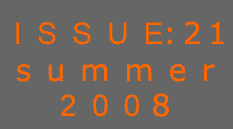
Concept of a Future
High Pressure - Boiling Water Reactor, HP-BWR
Frigyes Reisch
Nuclear Power Safety, KTH Royal Institute of Technology
Stockholm, Sweden
Abstract
Some four hundred Boiling Water Reactors (BWR)
and Pressurized Water Reactors (PWR) have been in operation for
several decades. The present concept, the High Pressure Boiling
Water Reactor (HP-BWR) makes use of the operating experiences.
HP-BWR combines the advantages and leaves out the disadvantages
of the traditional BWRs and PWRs by taking in consideration the
experiences gained during their operation. The best parts of
the two traditional reactor types are used and the troublesome
components are left out. The HP-BWR major benefits are;
1. Safety is improved; -Gravity
operated control rods -Large space for the cross formed control
rods between fuel boxes -Bottom of the reactor vessel without
numerous control rod penetrations -All the pipe connections to
the reactor vessel are well above the top of the reactor core
-Core spray is not needed -Internal circulation pumps to assure
hydrodynamic stability.
2. Environment friendly; -Improved
thermal efficiency, feeding the turbine with ~340 0C (15 MPa)
steam instead of ~285 0C (7MPa) -Less warm water release to the
recipient and less uranium consumption per produced kWh
3. Cost effective, simple; -Direct
cycle, no need for complicated steam generators -Moisture separators
and steam dryers are inside the vessel and secondary separators
and dryers can be installed outside the reactor vessel, inside
or outside the containment -Simple dry containment
1. Introduction
Now the time has come to move a step further
and develop an improved type of power reactors. Common sense,
public confidence and economic considerations demand that this
new design should not be a big leap from the presently functioning
machines, however it should be a significant improvement. Therefore
it is important to avoid those parts of the older designs which
caused trouble in the past e.g. PWR steam generators, BWR perforated
reactor vessel bottoms and instead rely only on a stable construction
with proven components which served well in the past. The High
Pressure – Boiling Water Reactor (HP-BWR) attains these
goals, by using the PWR; pressure vessel, the electro-magnetic
control rod operator and the BWR; core internals, circulation
pumps and steam and moisture separators.
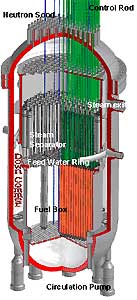
Figure 1. The High Pressure Boiling Water Reactor
2. Safety is improved
The control rods are gravity operated as this
system served well in PWRs. However here the form is like a cross,
as it is in the BWRs. This assures large space for the cross
formed rods between the BWR type fuel boxes.
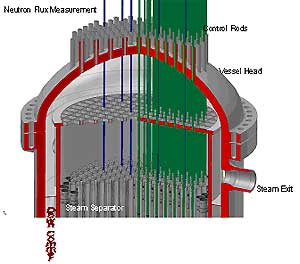
Figure 2. Reactor vessel head and reactor internals
The bottom of the reactor vessel now is without
numerous control rod penetrations a great advantage compared
with the previous design
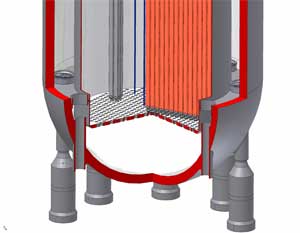
Figure 3. The bottom of the reactor vessel and circulation pumps
All the pipe connections to the reactor vessel
are well above the top of the reactor core. This means that a
pipe break would not empty the reactor vessel. Therefore core
spray is not needed.
Internal circulation pumps are used to assure
hydrodynamic stability. This way the orifices at the fuel channel
inlets are chosen so that the one phase pressure drop will dominate
over the two phase pressure drop to avoid hydrodynamic oscillations.
By applying natural circulation one could omit the circulation
pumps, however the margin to avoid hydrodynamic oscillations
would be diminished.
Compared with the traditional BWR the HP-BWR
has further advantages;

Table 1. Comparison between BWR and HP-BWR
due to the high temperature, improved thermal
efficiency and due to the increased negative power reactivity
coefficient further improved inherent stability.

Figure 4. Long term stability without the use of any control system.
Inherently stable reactor
3. Environment friendly
Improved thermal efficiency is assured by feeding
the turbine with ~340°C (15.5MPa) steam instead of ~285°C
(7MPa). The Carnot cycle theoretical efficiency (THot -
TCold )/ THot is for BWR ~46% and for HP-BWR
~51% at TCold = 300 K. This demonstrate the advantage
of the HP-BWR which utilizes the fuel more efficiently and releases
less warm cooling water to the environment per produced kWh
4. Cost effective, simple
The HP-BWR operates in direct cycle mode, no
need for complicated and expensive PWR steam generators and the
very complicated BWR reactor pressure vessel bottom. Moisture
separators and steam dryers are inside the pressure vessel and
secondary separators and dryers can be installed outside the
reactor vessel, inside or outside the containment. The containment
is a simple dry containment which allows easy entrance and inspections
and also minor repairs during operation.
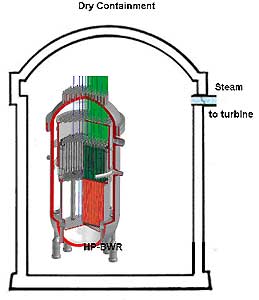
Figure 5: HP-BWR in a dry containment
5. Acknowledgements
Thanks to Hernan Tinoco of the Forsmark NPP and Joanna Peltonen
of KTH for their valuable support.
6. Reference
ENS
News, October 2007, Proceedings of the European Nuclear
Conference (ENC) 2007, Brussels
|

